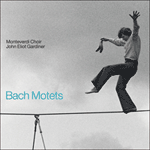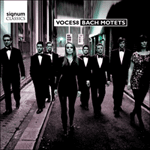The eight-part
Der Geist hilft unser Schwachheit auf is the only motet of the six that can be assigned with certainty to a particular occasion: it was written for the funeral of J H Ernesti, Rector of St Thomas’s School, on 24 October 1729. Its structure is not unlike that of ‘Komm, Jesu, komm!’ in that it divides into two movements: the first, subdivided into three contrasted sections marked by changes of time, is a setting of Romans 8, verses 26 and 7, while the second is a simple setting of verse 3 of Luther’s chorale ‘Komm, Heiliger Geist, Herre Gott’. The musical style, however, is much more modern. The first section of the first movement, for instance, is in the polychoral motet style, but uses a lively 3/8 metre and has a main theme that returns in fragments in the manner of a concerto ritornello theme. A set of original doubling instrumental parts, for strings and woodwind, survives for this work.
from notes by Peter Holman © 1990
Le motet à huit parties
Der Geist hilft unser Schwachheit auf est le seul des six à pouvoir être rattaché avec certitude à un événement donné: les funérailles de J. H. Ernesti, recteur de l’école Saint-Thomas, le 24 octobre 1729. Sa scission en deux mouvements n’est pas sans rappeler la structure de «Komm, Jesu, komm!»: le premier, subdivisé en trois sections contrastées marquées par des changements de mesure, met en musique les versets 26 et 7 de l’Épître aux Romains 8, tandis que le second est une simple mise en musique du verset 3 du choral luthérien «Komm, Heiliger Geist, Herre Gott». Le style musical est, toutefois, beaucoup plus moderne. La première section du premier mouvement adopte ainsi le style du motet polychoral mais recourt à un enjoué mètre à 3/8 et a un thème principal revenant sous forme de fragments, comme un thème de ritornello dans un concerto. Un jeu des parties instrumentales de doublement originales (pour cordes et bois) nous est parvenu.
extrait des notes rédigées par Peter Holman © 1990
Français: Hypérion
Die achtstimmige Motette
Der Geist hilft unser Schwachheit auf ist die einzige der sechs, die einer bestimmten Gelegenheit sicher zugeordnet werden kann—sie entstand für die Bestattung des Thomasschulrektors Johann Heinrich Ernesti am 24. Oktober 1729. Die Anlage ist ähnlich wie die von „Komm, Jesu, komm!“; das Werk hat zwei Sätze, von denen der erste in drei unterschiedliche Abschnitte fällt, die mit Tempowechseln bezeichnet sind. Vertont sind hier Verse des Römerbriefs (Röm 8, 26 und 27) während der zweite Satz eine schlichte Vertonung der dritten Strophe von Luthers Choral „Komm, Heiliger Geist, Herre Gott“ ist. Der musikalische Stil hingegen ist deutlich moderner gehalten. So steht der erste Abschnitt des ersten Satzes zwar im mehrchörigen Motettenstil, hat jedoch einen lebhaften 3/8-Rhythmus sowie ein Hauptthema, welches—ähnlich wie ein Ritornell-Thema eines Instrumentalkonzerts—in Fragmenten wiederkehrt. Es ist ein originaler Satz mit verdoppelnden Instrumentalstimmen (Streicher und Holzbläser) überliefert.
aus dem Begleittext von Peter Holman © 1990
Deutsch: Viola Scheffel


 Bach: Cantatas Nos 47, 96, 114, 116, 148 & 169
Bach: Cantatas Nos 47, 96, 114, 116, 148 & 169 Bach: Motets
Bach: Motets Bach: Motets
Bach: Motets
